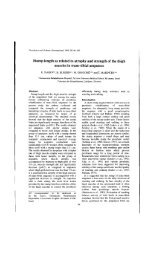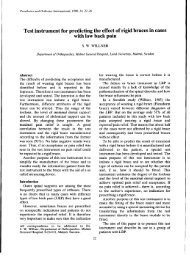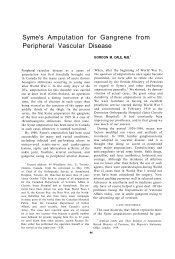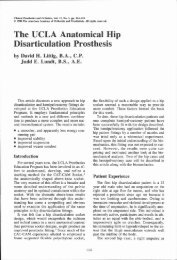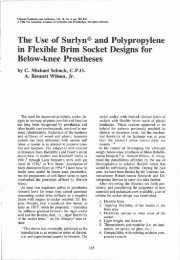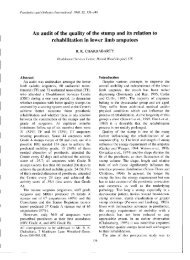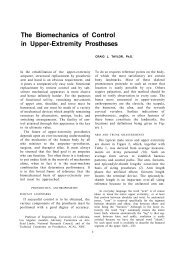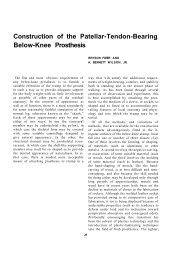Pro-Corn - O&P Library
Pro-Corn - O&P Library
Pro-Corn - O&P Library
Create successful ePaper yourself
Turn your PDF publications into a flip-book with our unique Google optimized e-Paper software.
The Susceptible Insensate Foot<br />
by Mitchell E. Kalter, M.D.<br />
Richard L. Jacobs, M.D.<br />
Introduction<br />
Patients with limbs which are both insensate<br />
and functionless often are best treated with amputation<br />
to improve hygiene, functional potential<br />
with prosthetics, and often cosmesis. There<br />
exists, however, a large population of patients<br />
whose lower extremities are insensate, but remain<br />
functional. Because of continued functional<br />
demands, and the loss of important protective<br />
mechanisms, breakdown of the delicate<br />
articulations occurs resulting in neuropathic arthropathy.<br />
While there are a multiplicity of disease<br />
states associated with neuropathic arthropathy,<br />
there are certain general principles and characteristics<br />
inherent in the final common pathway<br />
of the Charcot joint. In years past, neurosyphillis<br />
was the major cause. Nowadays, diabetes<br />
mellitus is by far the most common<br />
cause.<br />
This article will explore some of the historical<br />
aspects, causes, pathophysiology, clinical<br />
manifestations, and principles of treatment as<br />
they relate to neuropathic arthropathy of the<br />
susceptible insensate foot.<br />
Historical Aspects<br />
Jean Martin Charcot, at La Salpetriere in<br />
1868, first called attention to "ataxic" forms<br />
of arthropathy associated with neurological diseases,<br />
the most commonly recognized cause<br />
being tabes dorsalis. 1 , 2,4<br />
Charcot attributed the<br />
acute and destructive arthropathy to the loss of<br />
certain "neurotrophic influences" ncessary to<br />
support the normal joints. 6<br />
Charcot's contemporaries, Volkmann and<br />
Virchow, disagreed with this "trophic," or<br />
what was known as the "French" theory. 2<br />
They argued that the arthropathy was due to<br />
continued mechanical stress and trauma on an<br />
insensitive biological structure. 2<br />
These stresses<br />
continued in the absence of normal protective<br />
reflexes, which inevitably lead to a cycle of injury,<br />
inflammation, further injury, and finally<br />
instability and joint destruction. The end result,<br />
now the "Charcot joint."<br />
This basic process was gradually recognized<br />
in an ever broadening horizon of disease entities.<br />
Myelitis and syringomyelia were recognized<br />
as causes in 1875 and 1892 respectively. 1<br />
It was not until 1936 that Jordan described neuropathic<br />
arthropathy in the diabetic, 5<br />
now the<br />
most common cause of Charcot joints. 4<br />
Etiologic Factors<br />
The myriad of conditions which can produce<br />
Charcot joints is well outlined elsewhere. 2 , 6<br />
The three most common causes are diabetes<br />
mellitus, tabes dorsalis, and syringomyelia. 4<br />
The prevalence of neuropathic arthropathy in<br />
diabetes is only 0.1% to 0.5%, as compared to<br />
tabes dorsalis and syringomyelia which are 5%<br />
to 10% and 25%, respectively. 4<br />
The almost epidemic<br />
numbers of diabetics makes them the<br />
largest group seen clinically, however.<br />
Various theories have been espoused, such<br />
as Charcot's "neurotrophic" theory, Volkmann's<br />
"mechanistic" theory, and "neurovascular"<br />
theories. 4<br />
Each stresses some aspect of<br />
the observations made in the neuropathic ar-



